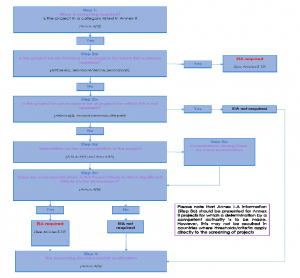Lesson 4 – EIA´s screening stage.
Welcome to the lesson on the screening process of the Environmental Impact Assessment (EIA). In this course, we will explore the systematic process of examining the environmental consequences of developmental actions in advance, and the screening stage that helps to identify whether a project’s effects on4 the environment are expected to be significant.
Environmental Impact Assessment (EIA) represents a proactive process that emphasizes the prevention of inputs, rather than reacting to environmental impacts after they have occurred. The EIA Directive requires public and private projects that could have significant effects on the environment to be subject to an assessment prior to a decision being given by the competent authority.
However, not every project automatically requires an environmental impact assessment. Therefore, the screening stage is crucial to determine whether an EIA is necessary and to ensure the efficient use of both public and private resources.
The screening process involves authorities examining the proposal or project description to determine whether a comprehensive EIA is needed, a simplified EIA is needed, more information or preliminary studies are needed before a screening decision can be reached, or the proposal is exempt from EIA (but may be subject to other approval requirements).
Projects listed in Annex I (Table 1) to the EIA Directive 2011/92/EU or the annexes to the EU Member state laws are automatically subjected to an EIA because their environmental effects are presumed to be significant. However, projects listed in Annex II (Table 2) do not necessarily have significant effects on the environment in every case, and national authorities must decide whether an EIA is needed. This is done through the screening procedure, which determines the effects of projects on the basis of threshold or criteria or case-by-case examination.

The threshold and criteria specified in Annex III of the EIA Directive refer to a mechanism by which quantitative or qualitative triggers are used to include or exclude the project from the EIA’s requirements. They must be set so that every project with likely significant effects on the environment is subject to an EIA, and those without significant effects on the environment are not subject to an EIA.
The thresholds refer to the size of the land used for a development project, location, output, cost and finance, environmental effects, etc. This method of screening establishes the thresholds for the key features of a project or an environmental parameter that exceeded the thresholds would require an EIA. The threshold values adopted in the EU Member States are mostly technical and based on the attributes of length (meters, kilometers), weight (tons), square meters, and performance capacity (kilowatts), but monetary thresholds (based e.g. on investment size) also exist.
Based on past experience with similar forms of development, the impact criteria can be divided into three categories which reflect the different degrees of potential environmental impact. Project proposals that are likely to have a significant environmental impact require an EIA report before they can be prepared. Project proposals that are located within or near a sensitive area also require an environmental impact assessment report.
In conclusion, the screening process is a vital stage in the Environmental Impact Assessment process that ensures the efficient use of both public and private resources while identifying whether a project’s effects on the environment are expected to be significant. Through the screening process, national authorities can determine whether an EIA is necessary, based on the thresholds and criteria specified in Annex III of the EIA Directive.